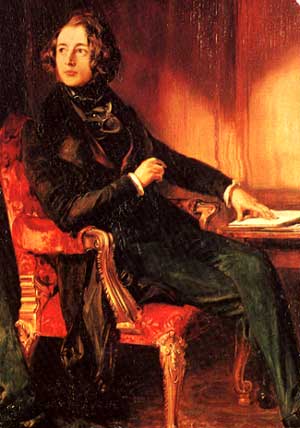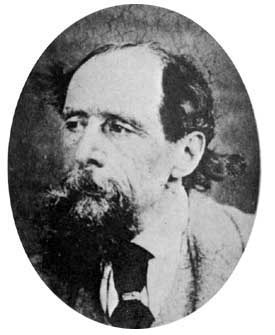Dickens's novels combine brutality with
fairy-tale fantasy; sharp, realistic, concrete detail with romance,
farce, and melodrama.; the ordinary with the strange. They range
through the comic, tender, dramatic, sentimental, grotesque,
melodramatic, horrible, eccentric, mysterious, violent, romantic, and
morally earnest. Though Dickens was aware of what his readers wanted
and was determined to make as much money as he could with his writing,
he believed novels had a moral purpose–to arouse innate moral
sentiments and to encourage virtuous behavior in readers. It was his
moral purpose that led the London Times to call Dickens "the
greatest instructor of the Nineteenth Century" in his obituary.
During his lifetime, Charles Dickens was
the most famous writer in Europe and America. When he visited America
to give a series of lectures, his admirers followed him, waited outside
his hotel, peered in windows at him, and harassed him in railway cars.
In their enthusiasm, Dickens's admirers behaved very much like the fans
of a superstar today.
DICKENS'S CONTEMPORARY REPUTATION
 Success came early to Dickens; he was
twenty-five when his first novel, Pickwick Papers, appeared and
made him one of the foremost writers of his day. It is an exuberantly
comic novel with almost no shadows, and readers expected all of his
novels to follow this pattern. His next two novels, Oliver Twist
and Nicholas Nickelby, fit readers' expectations well enough,
and they overlooked the social problems he exposed. As he aged,
Dickens's view of his society and human nature grew increasingly
somber, a fact which disturbed many readers and critics. A Tale of
Two Cities was attacked for having little, if any humor.
Success came early to Dickens; he was
twenty-five when his first novel, Pickwick Papers, appeared and
made him one of the foremost writers of his day. It is an exuberantly
comic novel with almost no shadows, and readers expected all of his
novels to follow this pattern. His next two novels, Oliver Twist
and Nicholas Nickelby, fit readers' expectations well enough,
and they overlooked the social problems he exposed. As he aged,
Dickens's view of his society and human nature grew increasingly
somber, a fact which disturbed many readers and critics. A Tale of
Two Cities was attacked for having little, if any humor.
Always concerned to make money with his
writings, Dickens took seriously the negative response many
readers had to his darker novels. He deliberately addressed their
discontent when he wrote Great Expectations, which he affirmed
was written "in a most singular and comic manner." In a letter to a
friend, he explained:
You will not have to complain of the want
of humour as in The Tale of Two Cities. I have made the
opening, I hope, in its general effect exceedingly droll. I have put a
child and a good-natured foolish man, in relations that seem to me
very funny. Of course I have got in the pivot on which the story will
turn too–and which indeed, as you will remember, was the grotesque
tragi-comic conception that first encouraged me. To be quite sure that
I had fallen into no unconscious repetitions, I read David Copperfield
again the other day, and was affected by it to a degree you would
hardly believe.
After his death, his literary reputation
waned and his novels tended not to be taken seriously. The novelist
George Meredith found them intellectually lacking:
Not much of Dickens will live, because
it has so little correspondence to life. He was the incarnation of
cockneydom, a caricaturist who aped the moralist; he should have kept
to short stories. If his novels are read at all in the future, people
will wonder what we saw in them.
DICKENS AND LATER READERS
Though Dickens's novels continued to be
read by large numbers of readers, his literary reputation was in
eclipse. There was a tendency to see his novels as appropriate for
children and young adults. From 1880 through the early
part of the twentieth century, Russian writers came into vogue and were
generally regarded as superior to Dickens. This preference is ironic
because the
Russian novelists both admired Dickens and learned from him. Turgenev
praised Dickens's work and even wrote for Dickens's magazine, Household
Words, during the Crimean War. Tolstoi wrote of Dickens, "All his
characters are my personal friends–I am constantly comparing them with
living persons, and living persons with them, and what a spirit there
was in all he wrote." Dostoevsky was so impressed that he imitated the
death of Little Nell, including the sentimentality, in describing the
death of Nelli Valkovsky in The Insulted and the Injured (1862).
Supposedly, during his exile in Siberia, he read only Pickwick
Papers and David Copperfield. Even if this story is
apocryphal, Dickens' influence on Uncle's Dream and The
Friend of the Family (1859), written while Dostoevsky was in
Siberia, is unmistakable. In yet another irony, English critics in the
1880s were
puzzled by Dostoevsky's similarities to Dickens.
Dickens' literary standing was transformed
in the 1940s and 1950s because of essays written by George Orwell and
Edmund Wilson, who called him "the greatest writer of his time," and a
full-length study by Humphrey House, The Dickens World. Critics
discovered complexity, darkness, and even bitterness in his novels, and
by the 1960s some critics felt that, like Shakespeare, Dickens could
not be classified into existing literary categories. This view of
Dickens as incomparable continues through the twentieth century. Edgar
Johnson
expresses the prevailing twentieth-century view in his assessment of
Dickens: "Far
more than a great entertainer, a great comic writer, he looks into the
abyss. He is one of the great poets of the novel, a genius of his art."
This is not to say that every critic or reader accepts Johnson's view;
F.R. Leavis could not take Dickens so seriously: "The adult mind
doesn't as a rule find in Dickens a challenge to an unusual and
sustained seriousness."
In the resurgence of Dickens's reputation,
his essays, sketches, and articles have received attention and praise.
K.J. Fielding believes, "If he were not so well known as a novelist, he
might have been recognized as a great English essayist."
A NOTE ON DICKENS'S PORTRAIT
 The large portrait (above) of Dickens was
painted when he was twenty-seven years old. I chose it to counteract
the image we have of writers and other famous men as middleaged or old.
Dickens, by his middle age, was so care-worn with deeply etched lines
in his face that he looks at least ten years older; he is only fifty in
the portrait on the left. The young Dickens was very good-looking and
often described as pretty or delicate; he was something of a fop
with his flashy waistcoats, jewelry, and flowing long hair.
The large portrait (above) of Dickens was
painted when he was twenty-seven years old. I chose it to counteract
the image we have of writers and other famous men as middleaged or old.
Dickens, by his middle age, was so care-worn with deeply etched lines
in his face that he looks at least ten years older; he is only fifty in
the portrait on the left. The young Dickens was very good-looking and
often described as pretty or delicate; he was something of a fop
with his flashy waistcoats, jewelry, and flowing long hair.
CHARLES DICKENS WEB SITES
Charles
Dickens Overview
A thorough presentation by the Victorian Web.
Materials on his biography, discussion of contempary background, e.g.,
political history, social history, religion. E-text of Great
Expectations and an overview. Look particularly at the section on
"The Economic Context of Dickens's Great Expectations" and "The
Evolution of Victorian Capitalism and Great Expectations."
Charles
Dickens Page
An informative site, with a biography, discussion
of the novels and characters, illustrations, Dickens London, Dickens
London Map, Dickens & Christmas, etc. A Q&A with a Dickens
expert. Unfortunately, it seems to acquire more ads every
semester.
Classic
Note on Great Expectations
Background of the novel, short summary, full
summary and analysis, character list, summary and analysis in groups of
ten chapters, links to other sites on Great Expectations,
e-text of the novel, essay on Pip's unrealistic expectations, a message
board, and a 40 question quiz. (The site also lists student papers; I
check such sites periodically.)
Charles
Dickens Page: Works & E-Texts
E-texts of the novels, short stories, and articles
as well as a few letters. Listservs about Dickens.
The
Dickens Project: University of California
The Dickens Project promotes the study and
enjoyment of Dickens's life, times, and work. It lists conferences,
publications, and Dickens fellowships. Life of Dickens, links to
Dickens sites, and Dickens archive.
Great
Expectations by Charles Dickens
1861 review of the novel in The Atlantic
Monthly.
Library
Images: Hume Lancaster's Portrait of the Hulks in the Medway
This portrait will give you a sense of what the
prison hulks (unseaworthy ships) were like.
John
Forster's Life of Dickens
Chapter on Great Expectations. Forster, a
close friend of Dickens, wrote this biography after his death.
Unfortunately the formatting is unattractive and the text is hard to
read, I think.
Newgate--Newgate
Prison
A picture of Newgate and Newgate Gate and a very
brief history of this prison.
DISCUSSION OF GREAT EXPECTATIONS
March 22,
2011

